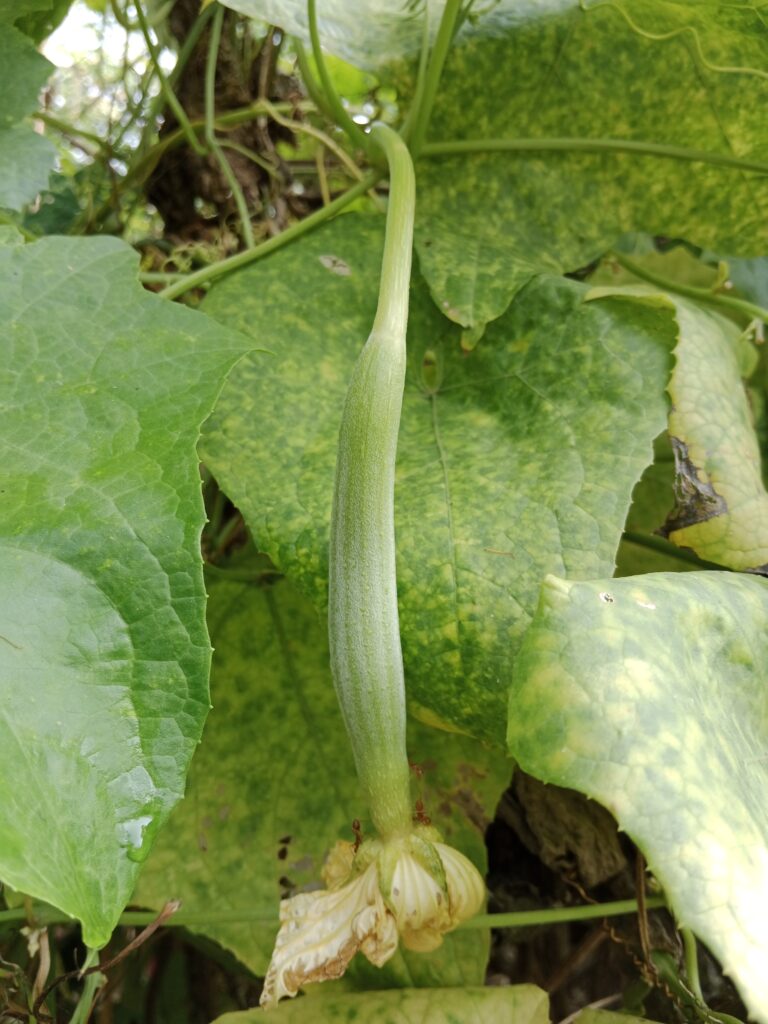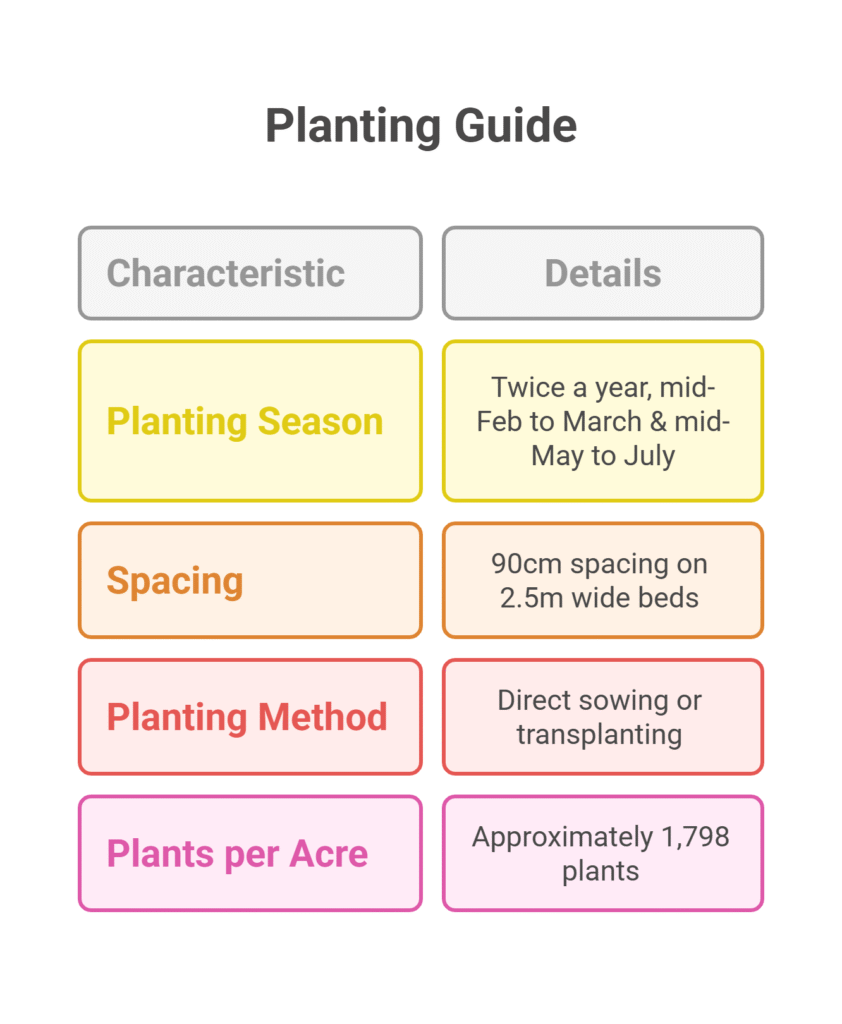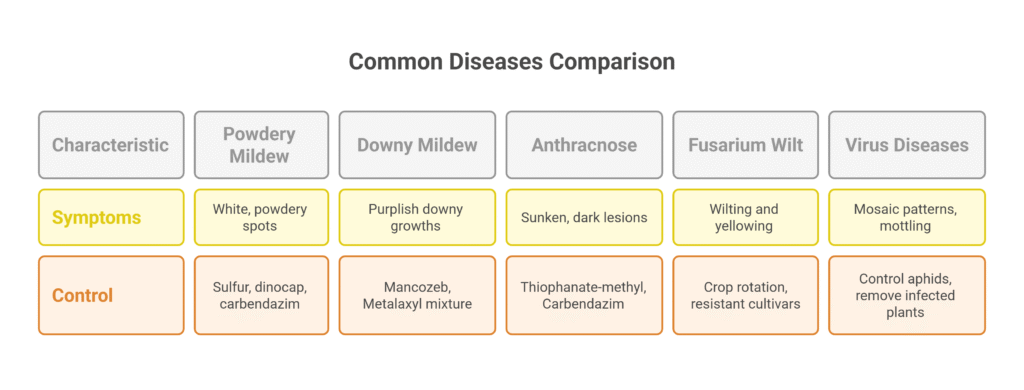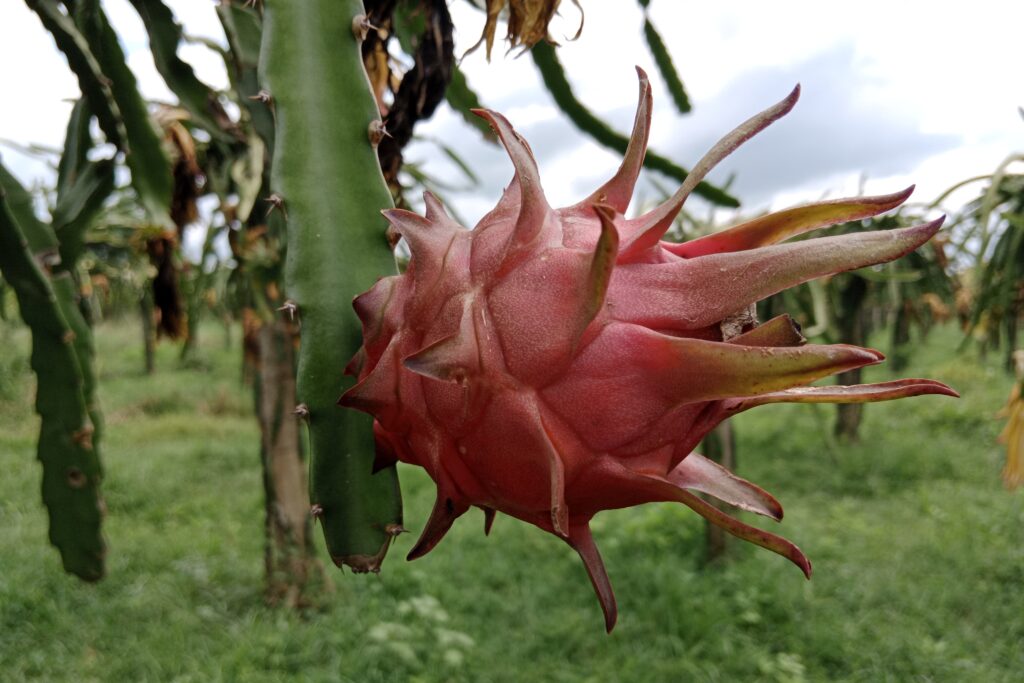Sponge Gourd Farming
Sponge gourd farming profit per acre has shown promising returns, making it a viable option for small to medium-scale farmers. According to the profit analysis, the total income from one acre of sponge gourd cultivation stands at NRs. 105,000, against a total production cost of NRs. 39,000, resulting in a healthy net profit of NRs. 66,000.

The most significant expenses are land preparation (26%) and harvesting (13%), while inputs for weed and pest control are relatively low, accounting for only 10% of the total cost. With a revenue-to-cost ratio of 2.7 and a profit margin of 63%, sponge gourd farming proves to be economically efficient. Farmers need to achieve a minimum yield of 2,600 kg per acre, at a market price of NRs. 15 per kg, to reach the break-even point.
Land Preparation
Land preparation for sponge gourd farming begins with 1–2 deep plowings (20–25 cm) to loosen the soil, enhance aeration, and support better root penetration, followed by 2–3 cross harrowings to break soil clods and achieve a fine, level tilth. Raised beds or ridges spaced 1.2–1.5 meters apart (center-to-center) are then formed to ensure proper drainage and provide space for vine growth; alternatively, flat beds with suitable spacing for trellising can be prepared. During the final land preparation, well-decomposed farmyard manure (FYM) or compost should be thoroughly incorporated into the soil to improve fertility.
Soil Type
Well-drained, fertile sandy loams or loam soils high in organic matter are the best types of soil for farming. Although the crop can grow on clay loam soils as long as the drainage is good, heavy clay, salty, or wet conditions should be avoided. Although it can withstand a wider pH range of 5.5 to 7.5, it prefers slightly acidic to neutral soils with an ideal pH range of 6.0 to 7.0.
Climatic Requirements
| Climatic Factor | Requirement Details |
| Temperature | Warm-season crop. Optimal growth between 25°C and 35°C. Germination requires >18°C. Growth halts below 15°C; frost is fatal. |
| Rainfall | Requires moderate to high rainfall (1000-1500 mm) evenly distributed. Cannot tolerate drought during flowering/fruiting stages. |
| Humidity | Prefers moderate humidity. High humidity combined with poor air circulation promotes fungal diseases. |
| Light | Requires full sunlight (at least 6-8 hours daily) for vigorous growth and good fruiting. |
Major Cultivars
There are two main types of cultivars: Smooth (cylindrical, Luffa cylindrica) and Ridged or Angled (ribbed, Luffa acutangula). Popular Indian smooth varieties include Pusa Chikni, Pusa Supriya, Konkan Harita, Phule Prajakta, and Punjab Sadabahar, while common ridged varieties are Pusa Nutan, Pusa Sneha, Swarna Manjari, Arka Sumeet, CO 1, and CO 2. Selection of cultivars should be based on local adaptability, preferred fruit type (for consumption when young or as a sponge), yield potential, disease resistance, and seasonal suitability.
Seed Rate
A seed rate of 2.0 kg per acre is recommended for optimal plant population. To enhance seed viability and improve germination rates, first gently scrape the seed coat using a filer, then soak the seeds in water for 24 hours before sowing.
Planting
a) Planting Season
Seeds are typically sown twice a year, with the first ideal sowing period occurring from mid-February to March and the second from mid-May to July, aligning with favorable climatic conditions for optimal germination and growth.

b) Spacing
For optimal plant growth and development, sow two to three seeds per hill on beds that are 2.5m wide, ensuring a spacing of 90cm between individual seeds. This spacing facilitates adequate air circulation, sunlight penetration, and room for vine expansion, ultimately promoting healthier plants and higher yields.
c). Planting Method
Planting can be done either by direct sowing or transplanting. In direct sowing, 2 to 3 seeds are placed per pit at a depth of 2–3 cm and later thinned to retain 1 or 2 healthy seedlings per pit. Alternatively, in the transplanting method, seeds are first sown in polybags or nursery beds, and 3 to 4-week-old seedlings with 2 to 4 true leaves are transplanted into prepared pits. Transplanting is preferred for achieving precise spacing and promoting early, uniform growth.
d) Number of Plants per Acre
Based on the above spacing, approximately 1,798 plants can be accommodated per acre.
Intercropping
Intercropping is feasible during the initial 6–8 weeks of growth, before the gourd vines spread extensively. Common intercrops include short-duration leafy vegetables like spinach and amaranthus, as well as radish, bush beans, and cowpea. It is advisable to avoid tall or heavy-feeding crops that compete for light and nutrients. This practice helps maximize land utilization and provides early income before the main crop fully occupies
Irrigation
Critical stages requiring careful water management include germination/seedling establishment, flowering, and fruit development. Water should be applied immediately after sowing or transplanting, with subsequent irrigation scheduled every 4-7 days during summer/dry periods and every 8-12 days in cooler seasons, while maintaining consistent soil moisture, especially during fruit set and growth.
Basin irrigation around plants is recommended initially, transitioning to furrow irrigation as the crop matures, though drip irrigation is highly recommended for optimal water conservation, efficiency, and reduced disease incidence. Crucially, perfect drainage must be ensured at all times to avoid waterlogging, which can cause root rot due to overwatering.
Fertilizer and Manure (Per Acre)
Conducting soil testing before fertilizer application is crucial to ensure that recommendations are accurately tailored to the soil’s nutrient status. Phosphorus and potassium are generally applied entirely as a basal dose during planting.
| Category | Specification | Application Details |
| Organic Matter | Well-decomposed FYM or Compost | 15-20 tonnes applied during land preparation |
| Inorganic Fertilizers | (General recommendation; adjust based on soil test) | |
| Basal Dose (at planting) | N (Nitrogen): 50-60 kg P₂O₅ (Phosphorus): 80-100 kg K₂O (Potassium): 50-60 kg | Full dose applied during planting |
| Top Dressing 1 | N (Nitrogen): 30-40 kg | At 30-35 DAS (Days After Sowing) / Vine initiation stage |
| Top Dressing 2 | N (Nitrogen): 30-40 kg | At the flowering stage (~60-65 DAS) |
| Top Dressing 3 | N (Nitrogen): 30-40 kg | At the peak fruiting stage (~90 DAS), if needed |
Weed Control
In the first 45 to 60 days following planting, before vine cover naturally reduces weeds, weed control is essential. Mechanical control using two to three hand weedings or hoeings at 20 to 25, 35 to 40, and 50 to 55 days after sowing (DAS) are effective techniques. Mulching with organic materials like grass clippings, dried leaves, or paddy straw, or with black plastic mulch, helps keep fruits clean, reduce weeds, and preserve soil moisture. Chemical control entails using herbicides such as Pendimethalin (400g a.i./acre) or Fluchloralin (400g a.i./acre) before weed emergence, following seeding.
Flowering and Fruit Management
The monoecious plant often begins to flower 40–50 days after seeding, producing both male and female flowers on the same plant. The ovary beneath the petals identifies female flowers, whereas male blooms appear earlier and in greater numbers. The primary pollinators are bees and other insects, and inadequate pollination might result in deformed or dropped fruits. It is crucial to promote pollinator activity by reducing the use of toxic pesticides during flowering in order to facilitate efficient pollination.
Under conditions of insufficient natural pollination, such as in protected agriculture settings or areas with low bee populations, growers employ hand pollination. This technique involves manually transferring pollen from male to female blossoms using a brush or cotton swab, optimally performed during morning hours.
Concurrently, maintaining adequate soil moisture and nutrient availability throughout flowering and early fruit development is critical for optimal results. While fruit thinning is seldom required, an excessive fruit set may necessitate the premature removal of malformed or damaged fruits.
Pest and Disease Management
Common Pests
a) Fruit Fly
Fruit fly larvae damage young fruits by boring into them, causing internal rotting and reduced yield. Control measures include bait sprays using Malathion and jaggery, traps with cue lure or methyl eugenol, and neem oil sprays. Bagging fruits can prevent infestation, while maintaining field sanitation by removing infested fruits and debris helps break the pest cycle.
b) Red Pumpkin Beetle
A major pest of cucurbit crops, the red pumpkin beetle causes defoliation and stunted growth by feeding extensively on cotyledons, delicate leaves, and blossoms. As they stay in the ground, the grubs harm the roots, which can weaken or even kill young plants.
Applying Carbaryl dust to the soil during the sowing process helps target the soil-dwelling grubs early on. Additionally, foliar sprays with insecticides such as Malathion or Carbaryl are advised to control adult beetle populations and stop additional above-ground damage.
c) Aphids
Aphids are small, sap-sucking insects that not only weaken plants by feeding on their juices but also act as vectors for various plant viruses, leading to stunted growth and poor yield.
Effective control includes spraying systemic insecticides such as Imidacloprid, Dimethoate, or Acetamiprid, which help reduce aphid populations and minimize virus transmission.
d) Spider Mites
These minuscule arachnids extract plant fluids, primarily from leaf undersides, causing visible stippling, yellow discoloration, and the production of fine silken webs over foliage. Severe infestations can significantly reduce plant vigor, photosynthetic capacity, and overall yield.
Effective chemical controls include miticides such as Abamectin, Dicofol, and wettable sulfur; thorough coverage of the undersides of leaves is critical for efficacy, given the pest’s preferred habitat. Regular scouting and early intervention are vital to prevent extensive outbreaks.
e) Epilachna Beetle (often called 28-spotted or Hadda Beetle)
Both the adult beetles and their larval stage (grubs) are foliage feeders. They consume the green tissue between leaf veins, leaving behind a characteristic skeletonized appearance of lacy, brown remnants. Severe infestations can cause significant defoliation, weakening plants, and reducing yields, particularly in vegetable crops like potato, eggplant, and tomato.
Initial management involves physically removing adults and grubs by hand-picking, especially effective in small gardens. For heavier infestations, chemical control options include spraying contact insecticides such as Malathion (0.05%) or Carbaryl (0.1%), ensuring thorough coverage of both leaf surfaces. Regular monitoring is essential for timely intervention.
Common Diseases
a). Powdery Mildew
White, powdery spots on leaves and stems are the hallmark of powdery mildew, a common fungal disease that, if left unchecked, can limit photosynthesis, restrict development, and diminish yields. Fungicides like sulfur (0.2%), dinocap (0.1%), carbendazim (0.1%), or hexaconazole (0.05%) are sprayed at the earliest indications of infection to effectively suppress the disease and safeguard plant health.

b) Downy Mildew
Downy mildew is a dangerous fungal disease characterized by purplish, downy fungal growths on the underside of leaves and yellow, angular patches on the upper surface. If not controlled, it can seriously reduce yields and interfere with photosynthesis. To suppress the infection and safeguard the crop, effective control involves the application of fungicides like Mancozeb (0.25%), a mixture of Metalaxyl and Mancozeb (0.2%), or Fosetyl-Al.
c) Anthracnose
Fruit rot, stem dieback, and early leaf drop are possible outcomes of this fungal disease, which appears as characteristic sunken, dark brown or black lesions on leaves, stems, and fruits. Control: Use protective fungicides like Thiophanate-methyl, Carbendazim (0.1%), or Mancozeb (0.25%) as soon as disease symptoms appear or as a preventative measure when conditions are favorable (warm, rainy weather); combine sprays with cultural practices like clearing away infected plant debris and enhancing air circulation.
d). Fusarium Wilt
Fusarium wilt is a destructive fungus that grows in soil and causes plants to wilt and turn yellow. It frequently results in plant death and large output losses. Crop rotation to prevent pathogen accumulation, the use of resistant cultivars, and soil solarization to sterilize the soil are all components of effective management. Carbendazim treatment at a rate of 2g/kg also enhances the general health of plants by shielding seedlings against early infection.
e) Virus Diseases (CMV, PRSV)
Virus diseases such as Cucumber Mosaic Virus (CMV) and Papaya Ringspot Virus (PRSV) cause symptoms like mosaic patterns, mottling, and distortion of leaves, severely affecting plant growth and yield. Managing these diseases involves controlling aphid vectors that transmit the viruses, promptly removing and destroying infected plants to prevent spread, and using virus-free seeds to ensure healthy crop establishment.
Harvesting
Harvest Timing and Methods: The crop matures approximately 70-80 days post-sowing. Vegetable-type fruits should be picked at an immature but fully formed stage, 8-12 days after fruit set, when tender, green, and reaching market size (typically 15-25 cm). Use sharp tools (knife/secateurs) every 2-3 days, retaining a short stem. Sponge-type fruits, however, require full vine ripening signaled by yellow/brown coloration and hardened, dry skin.
Post-Harvest Handling and Yield: Sponge fruits necessitate removal of skin/seeds, followed by thorough washing and sun-drying of their fibrous core. Young vegetable fruits demand gentle handling to prevent bruising; they must be sold promptly or stored briefly (1-2 weeks) under cool, humid conditions (10-12°C, 90% RH). Average production ranges between 66 and 83 quintals per acre.
Cost of investment per acre for Sponge gourd farming
| S.N. | Category | Cost (NRs.) |
| 1 | Land Preparation (Plowing) | 10,000 |
| 2 | Seed | 2,000 |
| 3 | Seed Planting | 2,000 |
| 4 | Trellis | 4,000 |
| 5 | Fertilizers and Manure | 4,000 |
| 6 | Irrigation | 5,000 |
| 7 | Weed Control | 1,000 |
| 8 | Pest & Disease Control | 3,000 |
| 9 | Harvesting | 5,000 |
| 10 | Miscellaneous Costs | 3,000 |
| Total Cost | 39,000 |
Income from Sponge gourd Farming per Acre
| Particulars | Yield (kg) | Price (NRs/kg) | Income (NRs.) |
| Sponge Gourd | 7,000 | 15 | 105,000 |
Analysis of Sponge gourd farming profit per acre
The profit analysis indicates a total income of NRs. 105,000 and a total cost of NRs. 39,000, resulting in a net profit of NRs. 66,000. Major expenses include land preparation (26% of total costs) and harvesting (13%), while weed and pest control contribute minimally at just 10%. The enterprise demonstrates strong profitability with a revenue-to-cost ratio of 2.7 and a profit margin of 63%. To break even, a minimum yield of 2,600 kg is required, based on a unit price of NRs. 15 per kg.
Crop Calendar for Sponge Gourd
(Based on Two Annual Planting Seasons in Tropical/Subtropical Regions)
| Growth Stage | Timing | Key Activities & Management Practices |
| Pre-Planting Preparation | 2-3 weeks before sowing | Land Prep: 1-2 deep plowings (20-25 cm) + 2-3 harrowings. Form raised beds (1.2–1.5m spacing). Incorporate 15-20 tonnes FYM/compost. Test soil pH (ideal: 6.0–7.0). |
| Sowing | Season 1: Mid-Feb–Mar Season 2: Mid-May–Jul | Seed Treatment: Scarify seed coat, soak 24 hours. Planting: Direct sow (2-3 seeds/hill at 2–3 cm depth) or transplant 3–4-week seedlings. Spacing: 90cm between hills on 2.5m beds (≈1,798 plants/acre). Apply basal fertilizer (N:50–60kg, P:80–100kg, K:50–60kg). |
| Early Growth (0–30 DAS) | Weeks 1–4 | Irrigation: Immediate post-sowing; every 4–7 days (summer) or 8–12 days (cool season). Weed Control: 1st weeding at 20–25 DAS; apply mulch/organic cover. Pest Control: Monitor for red pumpkin beetle (spray Carbaryl) and aphids (Imidacloprid). |
| Vegetative Stage (30–50 DAS) | Weeks 5–7 | Fertilizer: 1st top dressing (N:30–40kg) at 30–35 DAS. Weed Control: 2nd weeding at 35–40 DAS. Training: Install trellises for vine support. Pest Control: Check for spider mites (spray Abamectin) and Epilachna beetles (hand-pick or Malathion). |
| Flowering & Fruit Set (50–70 DAS) | Weeks 8–10 | Fertilizer: 2nd top dressing (N:30–40kg) at 60–65 DAS. Pollination: Ensure bee activity; hand-pollinate if needed (morning hours). Irrigation: Maintain consistent soil moisture. Disease Control: Prevent powdery/downy mildew (spray Mancozeb 0.25%). |
| Fruit Development (70–90 DAS) | Weeks 11–13 | Fertilizer: 3rd top dressing (N:30–40kg) at 90 DAS (if yield is low). Pest Control: Trap fruit flies (Malathion + jaggery); bag fruits. Harvest (Vegetable-type): Begin at 70–80 DAS; pick tender green fruits (15–25cm) every 2–3 days. |
| Maturation & Harvest (90+ DAS) | Weeks 14+ | Harvest (Sponge-type): Collect when fruits turn yellow/brown with hard, dry skin. Post-Harvest: – Vegetable-type: Store at 10–12°C, 90% RH (1–2 weeks). – Sponge-type: Remove skin/seeds; wash & sun-dry fibrous core. Yield: 66–83 qtl/acre. |
Sources
Punjab Agricultural University (PAU)
Vegetable Crops: Sponge Gourd Production Technology (ICAR publications)
Cultivation Practices for Cucurbits / Minor Vegetable Crops (FAO).



Pingback: Spine Gourd Farming Profit Per Acre -